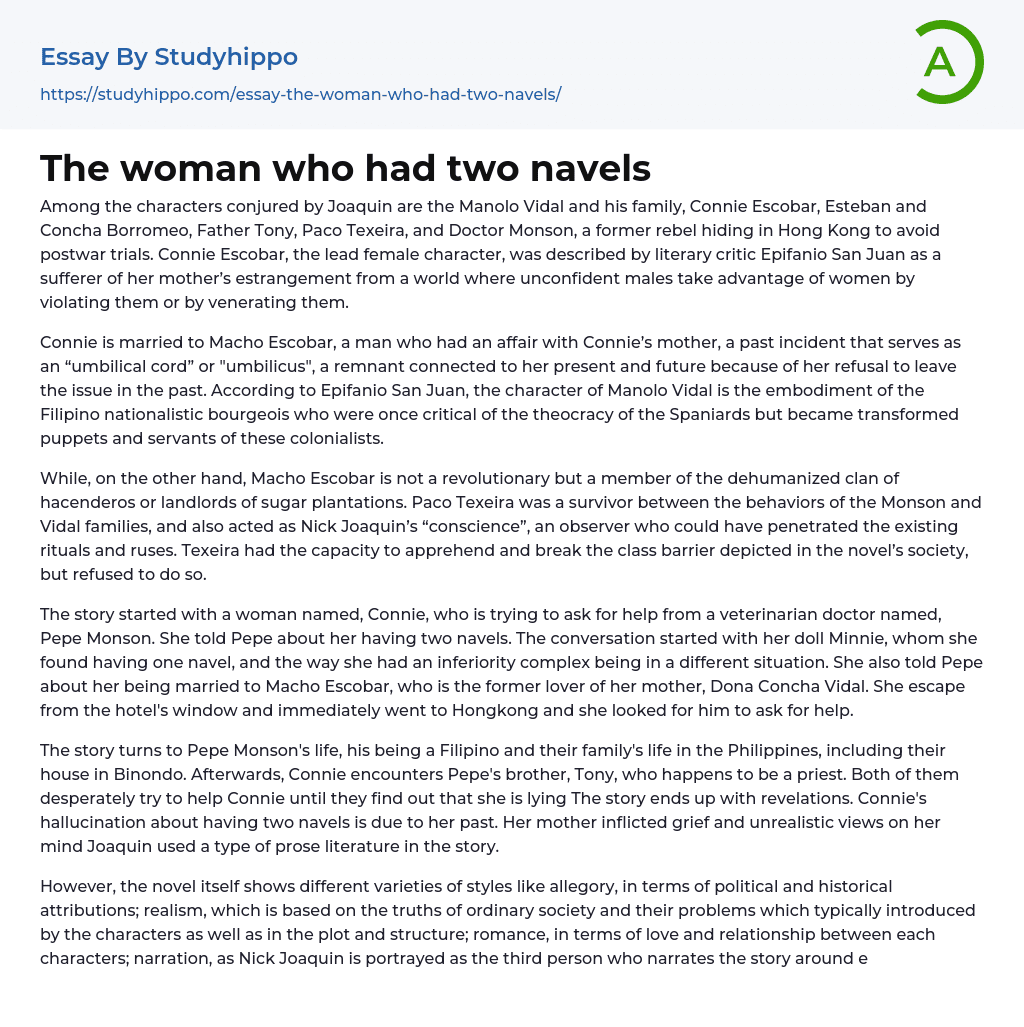Joaquin brings to life various characters, including Manolo Vidal and his family, Connie Escobar, Esteban and Concha Borromeo, Father Tony, Paco Texeira, and Doctor Monson. Doctor Monson, a former rebel, is hiding in Hong Kong to avoid postwar trials. According to literary critic Epifanio San Juan, Connie Escobar, the main female character, is portrayed as someone suffering from her mother's detachment from a society where insecure men exploit or idolize women.
Connie is married to Macho Escobar, a man who had an affair with Connie’s mother. This past incident serves as an “umbilical cord” or "umbilicus" that remains connected to her present and future because she refuses to let go of it. According to Epifanio San Juan, the character of Manolo Vidal represents the Filipino nationalistic bourgeois who were once crit
...ical of the Spaniards' rule but later became transformed into puppets and servants of the colonialists.
On one hand, Macho Escobar is not a revolutionary but a member of the dehumanized clan of hacenderos or landlords of sugar plantations. On the other hand, Paco Texeira was a survivor between the behaviors of the Monson and Vidal families, and also acted as Nick Joaquin’s “conscience”, an observer who could have penetrated the existing rituals and ruses. Texeira had the ability to understand and overcome the class barrier depicted in the novel’s society, but chose not to do so.
Connie reached out for help from veterinarian Dr. Pepe Monson, explaining her unique condition of having two navels. She began by discussing her doll Minnie, who only had one navel, and spoke of the insecurities she felt due to being i
a different situation. Connie also mentioned being married to Macho Escobar, her mother's former lover, and shared how she escaped through a hotel window and traveled to Hongkong in search of his assistance.
The text focuses on Pepe Monson's life, his Filipino identity, and his family's life in the Philippines, specifically their house in Binondo. Along the way, Connie meets Tony, Pepe's brother who is a priest, and they both make efforts to assist her. Eventually, it is discovered that Connie has been deceiving them. The story concludes with revelations about Connie's hallucinations, which stem from her troubled past. Joaquin employs a form of prose literature in this story.
The novel demonstrates various styles, including allegory for political and historical aspects, realism for portraying ordinary society and its issues through characters and plot, romance for depicting love and relationships, narration with the third-person narrator Nick Joaquin, and Picaresque for challenging societal prejudices with ideals and principles.
Despite the overall feminist style of writing in the story, Joaquin skillfully incorporates his unique literary style in every character and the progression of the narrative. Symbolically, he showcases the impact and legacy of the colonial eras. "Woman with Two Navels" portrays a man's battle to preserve his sanity amidst difficult conditions.
Joaquin expresses his journalistic style by immersing his subjects in the actual circumstances of the country during the colonization period of the Spanish and American regime. The writing has a casual and informal tone, with honesty, humanity, and irony. Joaquin presents the story as it occurred in a past-present manner, while also providing additional information to give the reader a comprehensive understanding.
- Book Summary essays
- Metaphor essays
- Reader essays
- Rhyme essays
- Literary devices essays
- Villain essays
- Books essays
- Genre essays
- Literary Criticism essays
- Writer essays
- Protagonist essays
- Simile essays
- Poem essays
- Book Report essays
- Book Review essays
- Greek Mythology essays
- Plot essays
- Tragic Hero essays
- Coming of Age essays
- Play essays
- Rhetoric essays
- Rhetorical Question essays
- Translation essays
- Understanding essays
- Reason essays
- Character essays
- Letter essays
- American Literature essays
- Literature Review essays
- Utopia essays
- Poetry Analysis essays
- Dante's Inferno essays
- Between The World and Me essays
- Incidents in The Life of a Slave Girl essays
- Flowers for Algernon essays
- Myth essays
- Everyday Use essays
- Boo Radley essays
- Genesis essays
- Richard iii essays
- Alice in Wonderland essays
- On the road essays
- Ozymandias essays
- The Nightingale essays
- Holden Caulfield essays
- Animal Farm essays
- 1984 essays
- A Hanging essays
- Shooting An Elephant essays
- A Tale Of Two Cities essays




